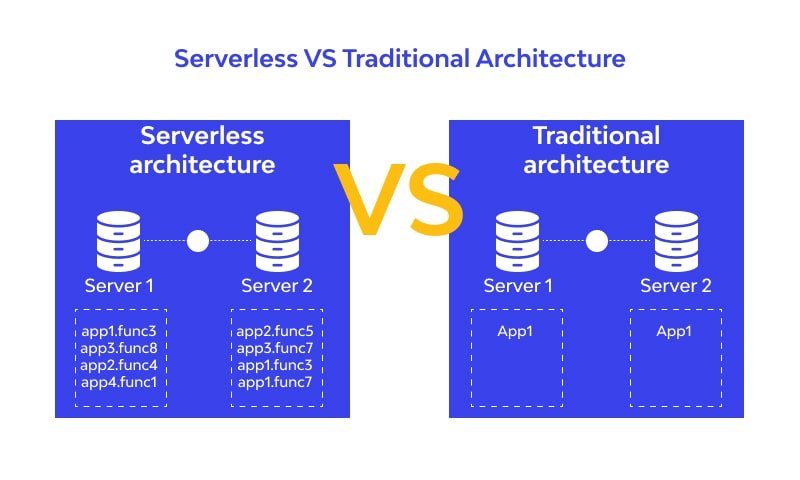Top Things Developers Need to Know About Serverless Technology
Top Things Developers Need to Know About Serverless Technology
As a developer, you must be updating yourself with the ongoing advancement in technologies; our main focus today is how serverless technology can be used by developers. It seems odd to think about serverless technology, but when it comes to the value, this brings to the table, it’s great for mobile app developers.
Serverless technology has been in existence since 2014 when Amazon Web Services unveiled the AWS Lambada serverless computing services. The race in this technology rose in 2016 when cloud service providers swung in that direction. The sky is just the beginning of this promising technology.
In 2017, Gartner published their Annual strategic tech trends which the firm described how the serverless technology was part and parcel of the mesh app and service architecture, commonly known as MASA. The MASA architecture is a multichannel solution that leverages APIs, containers, microservices, serverless computing, and the cloud to deliver flexible, dynamic, and modular solutions. In the journey to achieve this, more tools will be developed to make it a reality.
That is why we are going to discuss the top things that mobile app developers should be aware of when it comes to serverless tech. Let’s dive in.
1. Servers are still being used
Serverless tech can be described as an approach to replace virtual machines with computing power that exists once a request is placed, and it disappears after use. The serverless structure includes (BaaS)backend-as-a-service and (Faas) function-as-a-service. Functions are invoked because of specific events. Functions are described as small packages of code that run within containers to the point where they die once the task is finished.
This concept does not mean that servers are not in place. Servers are actually involved in the process. The difference between serverless computing and cloud services is that the server is not always running in a serverless architecture. Additionally, you don’t have to manage the servers or worry about how you can scale. You only have to deploy the code, and you are good to go. It also costs less because your servers run when they only need to.
2. Pay for what you use
As a developer, you need to develop applications appreciating the cost-effective nature of the serverless architecture. In serverless architecture, you don’t pay for idle resources. This is a great advantage because it is now possible for companies to cut down their costs of operation.
In research conducted by a cloud economics management company, it was stated that most virtual machine instances operate at sub 20% load. In serverless architecture, you only pay for what you use to avoid VM headaches.
Additionally, serverless providers can provide free tier services. To show you how powerful this technology is; in a Serverless conference, two real-world applications were presented on AWS Lambada, and they never surpassed the free tier limit. These applications never paid anything to AWS.
3. Focus on the development
Technology has grown over the years, from saving companies huge investments because of cloud technology to the use of serverless architecture that also does not need someone to manage cloud virtual machines.
Developers are now able to focus on mobile app development without the worry of server management because serverless providers worry about that on your behalf. Companies will then have more time for innovation and mobile app development. Additionally, it is easy to market because of the ease of deployment and scaling that serverless tech provides.
4. Microservices will still exist
Microservices are used to break down the code into small services which makes the process of development, deployment and scaling easier. Although functions are mostly used in serverless technology, microservices will still be used. This is because functions will not be able to do everything because of their granularity. For example, if your API is going to work with a database, there will be a faster response since things are ready and open which is not the case when it comes to functions.
Most importantly, as a developer, you need to know that a group of functions is like a micro-service. Microservice and functions can exist together in a complementary fashion. To an end user, the difference is not felt; but to a developer, how your PI is executed as a group of a single app or as a microservice is important.
Benefits of Serverless Architecture
Serverless computing offers a bunch of benefits that make developers jump for joy. Some of the Serverless computing benefits are as follows.
1. Cost Efficiency and Scalability
One of the biggest advantages of serverless architecture is its cost efficiency. You do not have to pay for idle server time or maintain a fleet of servers. Instead, you only pay for the exact amount of computing resources you use. Additionally, serverless architecture automatically scales your applications based on demand. So, whether you have a sudden surge in users or a quiet day in the office, your app can handle it without breaking a sweat.
2. Reduced Infrastructure Management
With serverless architecture, you do not have to worry about provisioning servers, configuring operating systems, or patching security vulnerabilities. Serverless architecture has significantly reduced the burden of infrastructure management. With traditional server-based systems, businesses need to allocate resources for infrastructure provisioning, monitoring, scaling, and maintenance.
However, with serverless architecture, organizations can focus solely on developing and deploying their applications, as the infrastructure management is abstracted away. This eliminates the need for managing servers, configuring databases, and handling load balancing.
3. Improved Development Productivity
Serverless architecture allows you to write code faster and be more productive. You do not have to worry about the practical details of infrastructure management, so you can spend more time writing code and less time on tedious server configurations. Serverless also promotes modular and reusable code, making it easier to develop and maintain applications.
Limitations of Serverless Architecture
Serverless architecture, despite its many advantages, does have some downsides that need to be considered.
1. Vendor lock-in
Firstly, one of the key cons is the potential for vendor lock-in. By adopting serverless services from a particular cloud provider, developers become dependent on that provider’s infrastructure and tools. This can limit flexibility and hinder the ability to switch providers in the future. Furthermore, serverless platforms can be costly. While the pay-per-use pricing model of serverless computing initially appears attractive, it can quickly become expensive if the application experiences sudden or unexpected spikes in usage. This can make it difficult to predict and manage costs effectively.
2. Lack of Control
Another con of serverless architecture is the lack of control over the underlying infrastructure. With traditional architectures, developers have direct control over the hardware and software stack. However, in a serverless environment, the infrastructure is abstracted and managed by the cloud provider. While this abstraction frees developers from infrastructure management tasks, it also means they have limited control over performance optimization and fine-tuning. This lack of control may lead to reduced performance or inefficient resource usage in certain scenarios.
3. Debugging and monitoring
Lastly, serverless architecture introduces additional complexity in terms of debugging and monitoring. As the code is executed in ephemeral environments, it can be challenging to reproduce and investigate issues that occur during runtime. Traditional debugging and logging techniques may not be as effective in a serverless environment, requiring developers to adopt new tools and practices. Moreover, since serverless platforms often involve multiple serverless functions working together as microservices, it can be difficult to trace and monitor the flow of data and events across these functions.
The potential for vendor lock-in, cost unpredictability, lack of control over infrastructure, and debugging complexities are aspects that must be considered when considering the adoption of serverless computing. Careful evaluation and consideration of these cons are vital to make an informed decision about whether serverless architecture is the right choice for a particular application or organization.
Key Components of Serverless Infrastructure
1. Function-as-a-Service (FaaS)
At the heart of serverless architecture lies Function-as-a-Service (FaaS). FaaS allows you to write small, single-purpose functions that are triggered by events. These functions are the building blocks of your application, and they run in a managed environment provided by the cloud provider. With FaaS, you can focus on writing the code for specific tasks, instead of worrying about the overall infrastructure. It is like having your genie who fulfills your coding wishes.
2. The client interfaces.
The client interface, as a component of serverless architecture, plays a critical role in facilitating interactions between clients and serverless functions. It serves as the gateway through which clients access and consume serverless services and functionalities. The client interface provides a seamless and user-friendly experience by abstracting away the complexities of serverless infrastructure, enabling clients to submit requests, receive responses, and manage their interactions with serverless functions.
By utilizing APIs, SDKs (software development kits), or web interfaces, the client interface allows clients to seamlessly integrate serverless services into their applications, enhancing their ability to leverage the scalability, flexibility, and cost efficiency offered by serverless architecture.
3. A Web Service on the Cloud
A web service provider component of serverless architecture is a crucial element that enables the efficient deployment and execution of web services without the need for managing the underlying infrastructure. This component allows developers to focus on writing code and implementing business logic while leaving scalability, availability, and resource provisioning to the service provider. By abstracting away, the server and operating system management, serverless architecture enhances scalability, reduces costs, and promotes rapid development and deployment of web services.
Additionally, with auto-scaling capabilities, the web service provider component ensures optimal performance by automatically adjusting resources based on the incoming traffic. This component of serverless architecture empowers developers to build and deliver robust web applications with minimal operational overhead.
4. A Security Service
A security service component is a crucial aspect of serverless architecture as it ensures the protection of both the serverless applications and the underlying infrastructure from potential security threats. This component comprises various security measures and protocols, such as authentication, authorization, encryption, and monitoring, to safeguard against unauthorized access, data breaches, and other security vulnerabilities. By integrating a robust security service component, serverless architectures can ensure the confidentiality, integrity, and availability of their applications, thereby instilling confidence in users and clients alike.
4. Backend Database
The backend database component of serverless architecture plays a crucial role in managing and storing data for serverless applications. It serves as a scalable and flexible storage solution that minimizes the overhead of infrastructure management for developers. By leveraging cloud-based databases such as Amazon DynamoDB or Google Firestore, serverless applications can efficiently handle data storage and retrieval, without the need for developers to worry about provisioning, scaling, or maintaining the database infrastructure.
With its ability to automatically scale up or down based on demand, the backend database component of serverless architecture ensures optimal performance and cost-effectiveness, enabling developers to focus on building and deploying applications rather than managing infrastructure.
5. API gateway
The API Gateway is a crucial component of serverless architecture as it acts as the entry point for all client requests. It serves as a central hub that enables developers to route, manage, and secure APIs efficiently. The API Gateway offers a range of functions such as request validation, authentication and authorization, rate limiting, and caching, allowing for enhanced control and flexibility.
By acting as a proxy between the client and the serverless applications, it simplifies the development process by abstracting away complexities and intricacies. The API Gateway streamlines the serverless architecture by providing a single point of entry and handling various tasks, resulting in improved scalability, security, and overall performance.
How do Mobile App Developers use Serverless Architecture in App Development?
Serverless computing has revolutionized the way mobile app developers create and deploy their applications. With traditional server-based infrastructures, developers needed to manage and provision servers, handle scaling issues, and allocate resources, which often led to higher costs and increased complexity. However, serverless computing provides a solution to these challenges by abstracting away the underlying infrastructure and allowing developers to focus solely on writing code for their apps.
- Firstly, serverless computing offers improved scalability for mobile app developers. In a traditional server-based model, developers needed to predict and provision servers based on anticipated usage, which often resulted in either underutilization or over-provisioning. With serverless computing, developers can take advantage of automatic scaling, as the infrastructure dynamically adjusts resources based on real-time demand. This enables mobile apps to handle sudden spikes in user traffic without any performance degradation, ensuring a seamless user experience.
- Secondly, serverless computing provides cost optimization for mobile app developers. In traditional models, developers had to pay for continuously running servers, regardless of actual usage. With serverless computing, developers are only billed based on the actual compute time used, resulting in significant cost savings. Additionally, the abstracted nature of serverless computing eliminates the need for infrastructure management, reducing operational costs and allowing developers to focus on their core competencies – app development and innovation.
- Lastly, serverless computing enables faster time-to-market for mobile app developers. With serverless architectures, developers can break down their applications into smaller, independent functions that can be deployed and scaled individually. This modularity allows for faster and more agile development cycles, as developers can focus on specific functionalities or features without being constrained by the entire application’s architecture. This rapid iteration capability facilitates quicker updates, bug fixes, and feature enhancements, ensuring mobile apps are always up-to-date and competitive in the market.
Serverless computing is a meaningful change for mobile app developers, providing improved scalability, cost optimization, and faster time-to-market. By freeing developers from infrastructure management and enabling them to focus solely on app code, serverless computing empowers developers to create highly scalable, cost-effective, and innovative mobile applications. With the rise of serverless platforms and services, app developers have a powerful tool at their disposal to create the next generation of mobile experiences.
How to Choose the Right serverless platform for your need?
Choosing the right serverless platform for your needs requires careful consideration of several key factors.
Firstly, you need to assess the scalability and performance requirements of your application. Different serverless platforms offer varying levels of scalability and can handle diverse types of workloads. If your application requires instant scaling and can handle unpredictable traffic spikes, you may want to consider a platform that can dynamically adjust its resources based on demand. Additionally, evaluate the performance metrics provided by different platforms and choose the one that aligns with your application’s performance requirements.
Secondly, it is crucial to consider the integration capabilities and ecosystem support of each serverless platform. If your application heavily relies on external services, such as databases, messaging queues, or analytics tools, you must ensure that the platform you choose supports seamless integration with these services.
Evaluate the platform’s documentation, community support, and available libraries or plugins to determine the level of support it offers for integrating with your required services. Choosing a platform with a thriving ecosystem can also help in finding ready-made solutions for familiar challenges or extending the functionality of your application.
Lastly, cost and pricing structures play a significant role in selecting the right serverless platform. Consider your application’s expected usage and the pricing models offered by different platforms. Some platforms charge based on memory usage, while others consider the number of requests or the amount of compute time.
Analyze the cost implications of each pricing model based on your usage patterns and expected load. It is also useful to consider any potential vendor lock-in and the availability of pricing calculators, which can help us estimate costs more accurately. Choosing the right serverless platform requires careful evaluation of scalability, performance, integration capabilities, ecosystem support, and pricing structures.
By considering these factors and understanding your application’s requirements, you can make an informed decision that ensures optimal performance, easy integration, and cost-effectiveness for your serverless application.

Serverless Architecture Vs Traditional Server Architecture
| Serverless Architecture | Traditional Server Architecture |
|---|---|
| Infrastructure is managed by the cloud provider | Infrastructure is managed by the organization |
| Pay only for actual usage | Pay for server capacity regardless of usage |
| In this architecture, scaling is easy. It scales based on demand. | In this architecture, scaling is tough. It can be manually scaled. |
| Functions are event-driven. | Applications follow a request-response model. |
| High availability and fault tolerance are built-in. | High availability and fault tolerance must be implemented. |
| Enable rapid development and deployment of microservices. | Requires more time and effort for development and deployment of microservices. |
Serverless Computing Trends
Serverless architecture is rapidly transforming the way applications are developed and deployed. This technology allows developers to focus solely on writing code without worrying about server management.
One significant trend is the increasing adoption of serverless functions in edge computing. Edge computing brings data processing closer to the source of data generation, reducing latency and improving performance. By combining serverless architecture with edge computing, developers can leverage the benefits of both technologies. Edge computing brings serverless functions closer to the users, enabling faster response times and enhanced user experiences.
Another future trend is the growth of multi-cloud serverless architectures. Rather than relying on a single cloud provider, organizations are starting to distribute their workloads across multiple cloud platforms. This approach ensures higher availability and reduces the risk of vendor lock-in. By using serverless functions, developers can easily deploy their applications across different clouds without worrying about infrastructure management.
Additionally, as serverless architecture becomes more mature, we can expect to see improvements in scalability and cost-effectiveness. Currently, serverless platforms automatically scale resources up and down based on demand. In the future, we can anticipate more intelligent auto-scaling algorithms that optimize resource allocation for better performance and cost efficiency. This will allow organizations to take full advantage of the benefits of serverless architecture, such as paying only for usage and eliminating idle resource costs.
Future trends in serverless architecture include the adoption of serverless functions in edge computing, the rise of multi-cloud serverless architectures, and improvements in scalability and cost-effectiveness. These trends will shape the future of serverless architecture, leading to faster and more efficient applications.
Companies that are using Serverless Architecture
Serverless architecture is an innovative approach to software development that is gaining popularity across various industries. Many forward-thinking companies have already adopted this technology to enhance their operations and improve the user experience.
Netflix:
One prominent example is Netflix, the world’s leading streaming entertainment service. By utilizing a serverless architecture, Netflix can scale its infrastructure dynamically based on traffic demands, ensuring uninterrupted streaming for millions of users worldwide.
Airbnb:
Another company that has embraced serverless architecture is Airbnb, the global online marketplace for vacation rentals and experiences. With millions of listings and users, Airbnb needs a robust and flexible infrastructure to handle the high volume of traffic. Serverless architecture allows them to scale their backend services instantly and efficiently, ensuring that their platform can handle the peak load during popular travel seasons.
Slack:
Slack, the popular team communication platform, is yet another company that has adopted a serverless architecture. As a real-time messaging app with numerous integrations and a vast user base, Slack requires a highly scalable infrastructure. By leveraging serverless functions, Slack can handle bursts of user activity without incurring excessive costs during periods of low usage. This enables them to provide a seamless communication experience for teams of all sizes.
By implementing serverless infrastructure, these companies can scale their services on-demand, ensuring high performance, seamless user experiences, and cost efficiency. As more companies recognize these advantages, the list of companies using serverless architecture is expected to grow rapidly in the coming years.
How does OTS help to build Serverless Architectures?
OTS helps developers build Serverless Architectures by providing a seamless and efficient platform for managing and orchestrating the various components required for such architectures. With OTS, developers can easily handle the scaling, monitoring, and deployment of serverless applications, allowing them to focus on writing and refining their code.
Through its robust infrastructure and automated processes, OTS enables developers to abstract away the complexities of managing servers and infrastructure, thereby simplifying the development and deployment process. By reducing the operational burden and providing built-in resilience, OTS empowers developers to create scalable and universally available serverless architectures without worrying about infrastructure management, resulting in reduced development time and increased productivity.
Conclusion
Understanding serverless architecture is crucial for harnessing the full potential of modern technology. Serverless computing offers numerous benefits such as scalability, cost-effectiveness, and decreased infrastructure management. By outsourcing the responsibility of server management to cloud providers, organizations can focus on their core business functions and deliver efficient, seamless experiences to their users. However, careful consideration must be given to the design and architecture of serverless applications to ensure optimal serverless computing security.
Embracing serverless architecture empowers businesses to innovate rapidly, achieve greater agility, and drive successful digital transformations.
Frequently Asked Questions
Q. Which programming languages are commonly used for serverless development?
Ans) We can use JavaScript (TypeScript) or Python for Serverless development.
Q. Can existing applications be migrated to a serverless architecture?
Ans) Yes, existing apps can indeed be migrated to a serverless architecture. Serverless computing eliminates the need for developers to manage and provision servers, allowing them to focus purely on the code and functionality of their applications. By breaking down the existing app into smaller, independent functions, developers can utilize various serverless services, such as AWS Lambda or Azure Functions, to handle various aspects of the app’s functionality. This migration not only assists in scaling the app easily but also reduces operational costs as serverless architectures only charge users based on their actual usage, making it a viable and efficient option for existing app migration.
Q. Is serverless architecture suitable for large-scale enterprise applications?
Ans) Serverless architecture has gained significant popularity in recent years, with businesses embracing it to enhance scalability, reduce operational costs, and improve overall efficiency. One popular serverless architecture is AWS Lambda, which allows developers to run their codes and automatically scale them in response to incoming requests without worrying about the underlying infrastructure. Another widely used serverless architecture is Microsoft Azure Functions, enabling developers to build event-driven applications in multiple programming languages.
Additionally, Google Cloud Functions offers serverless computing capabilities, allowing developers to focus solely on writing functions without concerning themselves with server management. These serverless architectures have revolutionized the way applications are developed and deployed, providing organizations with flexibility and agility in their operations.
Q. What are some popular serverless frameworks?
Ans) Some of the popular serverless frameworks are:
- Zappa
- Serverless
- AWS Chalice
- Claudia.js
- Architect (AWS,Node)
- Lambda Framework
- Flogo(GO, AWS)
- Jets
- Deep Framework
- Sigma








